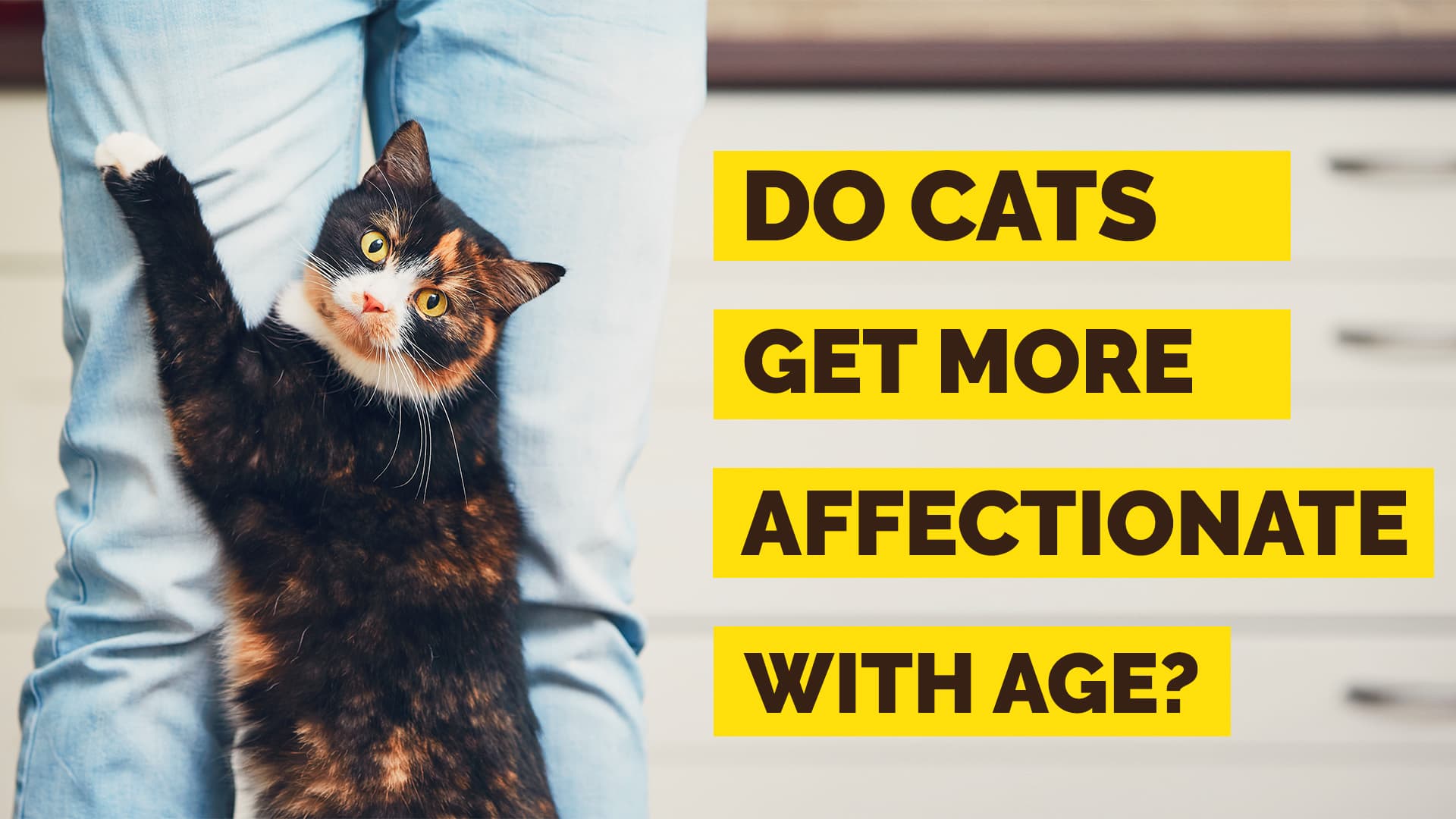These two topics, “cats” and “love” when brought together has been a point of conversation among people I feel for as long as cats have chosen to live with us.
You see how a cat shows her affection is subtle.
They are not like dogs who are out and about to show how much they love you.
The moment you enter the room, the tail wagging starts, the jumping, the running around and just expressing what they are feeling is very common with dogs.
With cats, however, things are very subtle.
Subtle but prominent.
Not everyone has eyes for subtleness, if I might add.
Some even go ahead and conclude that cats don’t show affection. Which isn’t true of course.
Cats have a way of showing affection which isn’t as forward as dogs but it is just as prominent and profound.
In this post, let discuss a cat’s affection and does it very with her age and the environment she exists in.
I am going to ask some of the most asked FAQs when it comes to cats and the affection or lack thereof, they express and the reasons behind it.
So, let’s begin with the most asked one and which is,
Do cats get more affectionate with age?
The answer is no one can truly pin point and mention looking at a cat in her early stages of growing up, whether she will get more affectionate or less affectionate with age, there are too many factors involved. But in most cases, that is indeed the case, cats do tend to get more affectionate as they age towards their owners.
Now, I think I need to point out here that one must really understand what affection is.
Especially, when it comes from cats or even other animals in general.
We are used to a certain kind of affection you see.
We identify certain acts as acts of affection and sometimes are unable to see beyond them.
For example, we understand how dogs act out of their liking for someone tail wagging, getting excited and running around etc. and our mind relates that as the act of affection.
Without us even knowing we relate that with affection. And when a cat doesn’t relay that kind of affection, we conclude that cats don’t love.
I was watching one episode from Jackson Galaxy’s my cat from hell, where a person’s idea of playing with his newly adopted cat was to rough her up like a dog.
I wouldn’t blame him for what he was doing though. Dogs understand rough play as actual playfulness from humans.
But you just can’t transfer that to a cat and complain if she starts developing fearful and aggressive behaviors.
So, my point is don’t misunderstand the lack of attention from your cat as non-love you see.
A cat’s way of showing affection is subtle, she may just slow bling at you, look at everything else except at you when you are in the room, raise her tail upright whenever you are around in a non-alarming and calm way.
These are all subtle body signs that she loves you.
By no way I am saying cats can’t so extreme affection, we know breeds that do, but if your cat doesn’t express her as eagerly as others do, doesn’t mean she is not affectionate.
That’s my only point.
Cat behavior change with age
Now there is something very hard in accepting that the little kitten that they adopted might be entering her twilight years.
I get that.
There maybe people reading this post who just adopted a kitten and looking at her aloofness, wondering do cats get more affectionate with age.
There may also be people who heard that cats do tend to get affectionate with age but are wondering why isn’t that the case with their cat.
The problem here is directional conclusion rather than a subjective one.
Never can you conclude something about your cat by looking at one, two or hundreds of cat for that matter.
That’s the problem or that’s the beauty about cats.
Every cat is unique in her ways.
Yes, one can learn a lot about them by observing them true. But those learning should become waypoints and guidelines and not conclusions you see.
Because every cat just like humans face different situations and eco systems in their life that tends to shape them. I hope I was able to relay my point here.
But I feel a general unfolding of how a cat’s behavior changes with age should give you necessary insights you need.
You can then use these insights to understand your cat and possibly urge her to show more affection to you in her own ways without trying to force it out of her.
So here is a pretty general account of how a cat’s behavior changes with age,
- 0-6 months: Your little kitten is getting ready to take on the world, it’s just way too big for her.
She is taking in huge chunks of information that she is getting from her environment and her attitude is almost always playful. - 6-12 months: This duration in her life is equivalent to human teens.
She is full of energy and has started thinking she is the boss of everything.
Her exploratory instincts and the capacity to wreak havoc is at its peak here. - 1-2 years: Your cat is beginning to be an adult here and this is that stage in her life where she will develop a lot of her lifelong tendencies.
Cat owners need to handle her consciously here because any unconscious and bad behaviors can get firmly rooted in her psyche.
Lots of playtime and spending time with your cat will definitely increase her affection and bond with her. - 3-6 years: This is the age where your cat is fully matured and is a full-fledged cat. Whatever she has learnt and whatever tendencies she has formed in the ecosystem she has existed in settles in her here.
So this age is actually where their personality gets concretized. - 7-10 years: Your cat still has energy but you will find her shifting and settling in her already set ways in these middle ages. This is also the age where many people see a shift in her affection. You will her more resistant to changes and routine here as well.
- 11-14 years: Your cat is a senior citizen now. She may start experiencing health issues frequently around this age such as deteriorating vision or hearing and cognitive decline.
- 15+ years: The golden age of cats. Cats in this age group can be categorized as geriatric. They will require a lot more attention and a conscious diet regime at this age. It’s important to note here that any sudden behavioral changes after this age necessitates a vet visit.
So, you see, it’s very similar to any other thing in nature.
Just like a flower goes through different phases in time, so does your cat.
And in all of these stages in her life her affection may mean different things.
When she is a kitten, she wants something or someone to play with, she won’t cuddle or lie in your lap.
But she will see you allowing her to express herself as an act of your love(which is in your hands) and express some back in her own ways you see.
How to make your cat more affectionate?
By no way I am trying to teach you love and affection, let me be clear upon that.
I am not an authority in that space, no one is actually to be really honest, but you see I am a good observer of things.
And I like to relay stuff the way I see it.
So now that we have broadened our understanding into what affection is and the subtle ways of a cat.
Let me tell you some simple things you can do which will possibly increase affection in your cat/
I of course don’t need to reiterate that every cat is different, every breed is different and every situation a cat exists in is different.
So, take what I say as a subjective knowledge and not conclusions.
1.Keep it simple.
We like to overthink things.
I know many think cats are complicated and mysterious.
I don’t necessarily believe that’s true.
Here is the thing.
Cats are simple beings who are driven by primary instincts of survival and procreation.
As long as her basic needs are taken care of properly, she will love you. It’s as simple as that.
Take care of simple things like giving her good food, clean water, fun toys to play with, a clean litter box and clean utensils to use and leave her alone.
You will see she will love you.
2. Make her feel safe while she eats
This is again an extension of previous point actually.
When you are opening a can of food in front of her and she is gawking at you.
Say a kind and affectionate word.
She will associate the kind gesture followed by her favourite food as an expression fo your love.
This is positive reinforcement.
Occasionally, not too much though pet her while she eats without startling her so that she feels secure.
3. Have dedicated playtime
How much playtime you need with your cat will depend upon your cat breed to be honest.
For example, a breed like bengal needs a lot more playtime when compared with Russian Blues owing to their excess energy.
But in general, all cats need toys and scratching posts to express their pent up energy and nature.
So, make it a point to socialize and play with your cat if you aren’t already doing it and it will do wonders.
4. Use some catnip
Now not all cats respond to catnip in a similar way.
But if your cat goes all bonkers on catnip, guess what you have a key to her heart.
Catnip can have a kind of freeing effect on cats. It is known to cause timid felines to loosen up a bit you know.
And when used consciously can make an aloof cat more cuddly and friendlier in its influence.
So, try it.
5. Slow blink at your cats.
Just the other day I created a post on what does the slow blink of a cat mean.
Well, in short it means your cat is saying I feel comfortable in your presence and I like it.
Basically, a cat version of saying I love you.
But don’t stare alright for too long or you risk the chance of being misunderstood as someone with an aggressive stare.
So, moderation and let your slow blink come from within your heart.
They understand that believe you me.
These are 5 primary techniques you should try.
And there are other simple things that you can try too like giving her treats at the right time when she is behaving properly to reinforce that character, establishing a good routine with her, messaging her gently etc.
Let me know in the comments section if you wish me to elaborate into these techniques further.
Why is my cat so affectionate all of a sudden?
While we are at a subject of cats and their affection, I feel I need to cover this question as well.
Many cat owners frequently ask this of me.
Why is may cat so affectionate all of a sudden? Why is my aloof furball all cuddly now?
I have seen many cat owners come to the conclusion that cats that are clingy are just spoiled or demanding.
They provided them too much attention when they were kitten and because of that the cat is used to having things her own way.
While that can be one reason but in no way can that be the only reason.
There can be many reasons behind this and it can depend on so many causes but here are the more probable ones.
- Your cat may just be wanting more affection than she is already getting.
- There has been a sudden change in her environment/routine that is making her anxious and nervous.
- She may be scared of a new arrival in the home (a pet/guest/child) that may be disturbing her normal dynamics in the house.
- Your cat may also have developed an unhealthy attachment with you.
- The cat maybe in heat or pregnant.
- Your cat may also be unwell.
So, in your particular case you will be able to understand the reason behind her sudden affection with your observation with these points in mind.
And in most cases, you will also be able to correct it by taking the necessary actions.
What Is The Normal Level Of Affection In Most Cats?
Now this again is a very subjective question.
But I think it is important to answer it so that you can have a benchmark as to understand what the sudden change in your cat’s affection may mean.
So, there are cats and cat breeds that just love to shower you with all their love.
And similarly, there are a lot of breeds that prefer subtle forms of affection and won’t be so out there to express it.
Every cat is unique and where your cat stands in affection will be clear to you by how you perceive she normally is in her daily life.
Still the best way to see if your cat is expressing normal affection levels is by seeing that it is not expressed or supressed in extremes.
If your cat just doesn’t approach you or is running from you, these are the signs that your cat is afraid of you.
You need to immediately check what the problem is and take necessary actions.
A cat that is absolutely refusing to leave your shadow can be equally problematic. It can cause physical harm to them (you accidentally stepping on them) and they cause problems in your house when you leave them alone.
A truly happy cat will neither be overly clingy or absolutely aloof.
She will seek attention when she wants it depending on her nature that she normally expresses and other times she will be busy with herself.
These are the usual times when a cat generally seek attention(it may be different in your case),
- Early in the morning she wakes you up for food.
- As soon as you get back from work.
- Whenever she knows its playtime or feeding time.
Of course, it may vary for you but the extremities is what you need to watch out for.
I hope I was able to cover a lot of grounds when we talk about cats and affection in one breath.
Once again, I need to point out that affection from cat is subtle, but in its subtleties its very prominent.
It takes a very special person to understand these subtleties and keep caring for his or her pet. 😊
Mention any queries that you might have in the comments section below and I will answer them to the best of my knowledge.
Take great care of yourselves and your cat and I will see you in the next one.
BBye 😊




